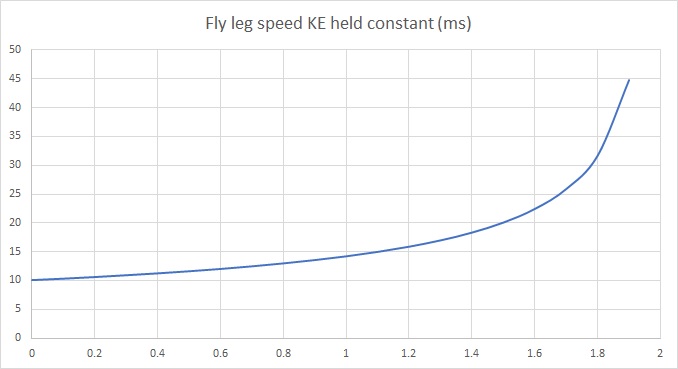I'll add some description to what I've done to help people understand it.
I'll state the conditions up front. In this model I am simulating a tethered cast with 20 m of fly line, with a linear density of 0.001 kg/m. The initial speed of the fly leg is 10 m/s.
Standard thinking has been that in the absence of all other forces and if kinetic energy is conserved, since the rod leg is not moving the kinetic energy would be concentrated in the fly leg. Given that mass of the fly leg is constantly decreasing the speed of the fly leg must be increasing since KE=.5mv^2. If we follow that logic and, in the absence of all other forces (other than the rod tip holding the rod leg back), then we can calculate the expected speed of the fly leg to be as shown:

- Fly Leg speed KE held constant.jpg (38.92 KiB) Viewed 331 times
I can't show the final speed in this case because it goes to infinity.
I've always had a problem with this concept. First, because the fly leg obviously never accelerates as in this graph. For most cast the fly leg speed stays fairly constant. In some cases we've seen some acceleration of a few percent but never anything approaching this type of curve at any time. In other cases the fly leg will slow down (insufficient energy to complete turnover) or remain constant. This tells me that we don't really have a good understanding of what's happening as the line unrolls. KE is obviously not being concentrated in the fly leg but that is typically written off as losses due to other forces and that if were to make a cast while free falling in the vacuum of space then we would see exactly the velocity profile shown. Since we obviously aren't going to make any casts while free falling in a vacuum it's hard to refute that.
The problem with the concept above is that it is based on the idea that the rod leg is not moving so it can't have energy. This would be true if it were a point mass or even a collection of point masses but its a distributed mass. In order to determine if it has KE we have to look at the motion of it's center of mass. Since the rod leg is constantly getting longer it's center of mass is moving and if we look at the motion of it's center of mass and it's mass we can determine the amount of KE that the rod leg actually has. Similarly, if we want to determine the KE of the rod leg we need to use it's center of mass to determine it's actual velocity for purposes of determining its KE.
If we do that then we get the following chart: (Note) I've scaled the velocity of the fly leg down by a factor of 20 so it fits on the graph without squishing the KE values into a tiny bar at the bottom of the chart in case anybody is thinking of replicating the result. I've also used the velocity of a single point on the line (the fly) rather than the velocity of the center or mass.
What we are seeing is that the combined KE of the fly and rod legs remains constant throughout the cast. It's not being concentrated into the fly leg and the fly leg speed remains constant rather than increasing to infinity. If you were to make this cast while free falling in the vacuum of space then this is what I expect to see. It also tells me that when casting while free falling in space that loop size won't make any difference. The initial cast will continue to fully roll over or until internal losses cause the KE to drop to zero.
I could have added a loop but since the loop velocity and its mass distribution does not change during the cast the total KE will remain the same with or without a loop and regardless of the loop size. Adding loop morph would just make it difficult to model but I expect a similar result.
I also expect that the result will be the same for the untethered cast, i.e. total energy of the fly and rod legs will remain constant throughout the cast but I haven't modelled that yet. If anyone want to take a stab at it then please feel free.
There are, of course, other forces acting on the line but they are beyond the scope of this topic (I believe). My goal was to determine what was happening with energy distribution in the line during the cast rather than it being concentrated in the fly leg and I think I've done that.
I welcome any questions or discussion within the confines of this topic. I have some other questions that I think I have at least a partial answer to and will be starting separate discussions on those.